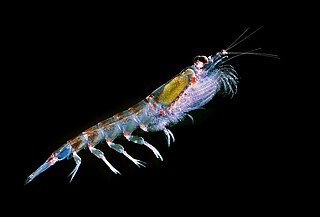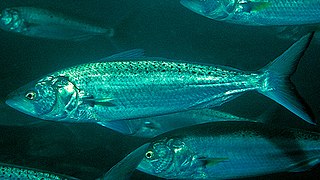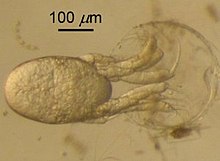
Salmon is the common name for several commercially important species of euryhaline ray-finned fish from the genera Salmo and Oncorhynchus of the family Salmonidae, native to tributaries of the North Atlantic (Salmo) and North Pacific (Oncorhynchus) basins. Other closely related fish in the same family include trout, char, grayling, whitefish, lenok and taimen, all coldwater fish of the subarctic and cooler temperate regions with some sporadic endorheic populations in Central Asia.

Antarctic krill is a species of krill found in the Antarctic waters of the Southern Ocean. It is a small, swimming crustacean that lives in large schools, called swarms, sometimes reaching densities of 10,000–30,000 individual animals per cubic metre. It feeds directly on minute phytoplankton, thereby using the primary production energy that the phytoplankton originally derived from the sun in order to sustain their pelagic life cycle. It grows to a length of 6 centimetres (2.4 in), weighs up to 2 grams (0.071 oz), and can live for up to six years. It is a key species in the Antarctic ecosystem and in terms of biomass, is one of the most abundant animal species on the planet – approximately 500 million metric tons.

Northern krill is a species of krill that lives in the North Atlantic Ocean. It is an important component of the zooplankton, providing food for whales, seals, fish and birds. M. norvegica is the only species recognised in the genus Meganyctiphanes,

Krill are small and exclusively marine crustaceans of the order Euphausiacea, found in all the world's oceans. The name "krill" comes from the Norwegian word krill, meaning "small fry of fish", which is also often attributed to species of fish.
Krill oil is an extract prepared from a species of Antarctic krill, Euphausia superba. Processed krill oil is commonly sold as a dietary supplement. Two components of krill oil are omega-3 fatty acids similar to those in fish oil, and phospholipid-derived fatty acids (PLFA), mainly phosphatidylcholine.

Astaxanthin is a keto-carotenoid within a group of chemical compounds known as terpenes. Astaxanthin is a metabolite of zeaxanthin and canthaxanthin, containing both hydroxyl and ketone functional groups. It is a lipid-soluble pigment with red coloring properties, which result from the extended chain of conjugated double bonds at the center of the compound.

The Chinook salmon is the largest and most valuable species of Pacific salmon. Its common name is derived from the Chinookan peoples. Other vernacular names for the species include king salmon, Quinnat salmon, Tsumen, spring salmon, chrome hog, Blackmouth, and Tyee salmon. The scientific species name is based on the Russian common name chavycha (чавыча).

The Marine Stewardship Council (MSC) is a non-profit organisation which aims to set standards for sustainable fishing. Fisheries that wish to demonstrate they are well-managed and sustainable compared to the MSC's standards are assessed by a team of Conformity Assessment Bodies (CABs).

Pink salmon or humpback salmon is a species of euryhaline ray-finned fish in the family Salmonidae. It is the type species of the genus Onchorhynchus, and is the smallest and most abundant of the seven officially recognized species of salmon. The species' scientific name is based on the Russian common name for this species gorbúša (горбуша), which literally means humpie.

The coho salmon is a species of anadromous fish in the salmon family and one of the five Pacific salmon species. Coho salmon are also known as silver salmon or "silvers". The scientific species name is based on the Russian common name kizhuch (кижуч).

Euphausia is the largest genus of krill, and is placed in the family Euphausiidae. There are 31 species known in this genus, including Antarctic krill and ice krill from the Southern Ocean, and North Pacific krill in the Pacific Ocean.

The krill fishery is the commercial fishery of krill, small shrimp-like marine animals that live in the oceans world-wide. The present estimate for the biomass of Antarctic krill is 379 million tonnes. The total global harvest of krill from all fisheries amounts to 150–200,000 tonnes annually, mainly Antarctic krill and North Pacific krill.

Arripis trutta, known as the Australian salmon in Australia and as kahawai in New Zealand, is a South Pacific marine fish and one of the four extant species within the genus Arripis, native to the cooler waters around the southeastern Australian coasts and the New Zealand coastline. Other common names for this species include Eastern Australian salmon, bay trout, blackback salmon, buck salmon, cocky salmon, colonial salmon, newfish and salmon trout.
This page is a list of fishing topics.
Aker BioMarine is a Norwegian fishing and biotech company providing krill products through a fully documented and secured catch and process chain. Based in Oslo, Aker BioMarine is part of the Aker Group and the company also created Eco-Harvesting.

Forage fish, also called prey fish or bait fish, are small pelagic fish which are preyed on by larger predators for food. Predators include other larger fish, seabirds and marine mammals. Typical ocean forage fish feed near the base of the food chain on plankton, often by filter feeding. They include particularly fishes of the order Clupeiformes, but also other small fish, including halfbeaks, silversides, smelt such as capelin and goldband fusiliers.
Euphausia crystallorophias is a species of krill, sometimes called ice krill, crystal krill, or Antarctic coastal krill. It lives in the coastal waters around Antarctica, further south than any other species of krill. The specimens for the species' original description were collected through holes cut in the ice by Robert Falcon Scott's Discovery Expedition, several thousand having been donated by Thomas Vere Hodgson.

Salmon is a common food fish classified as an oily fish with a rich content of protein and omega-3 fatty acids. Norway is a major producer of farmed and wild salmon, accounting for more than 50% of global salmon production. Farmed and wild salmon differ only slightly in terms of food quality and safety, with farmed salmon having lower content of environmental contaminants, and wild salmon having higher content of omega-3 fatty acids.
The following outline is provided as an overview of and topical guide to fisheries:

Helicolenus hilgendorfii, Hilgendorf's saucord, is a species of marine ray-finned fish belonging to the subfamily Sebastinae, part of the family Scorpaenidae. It is found in the northwestern Pacific Ocean.














